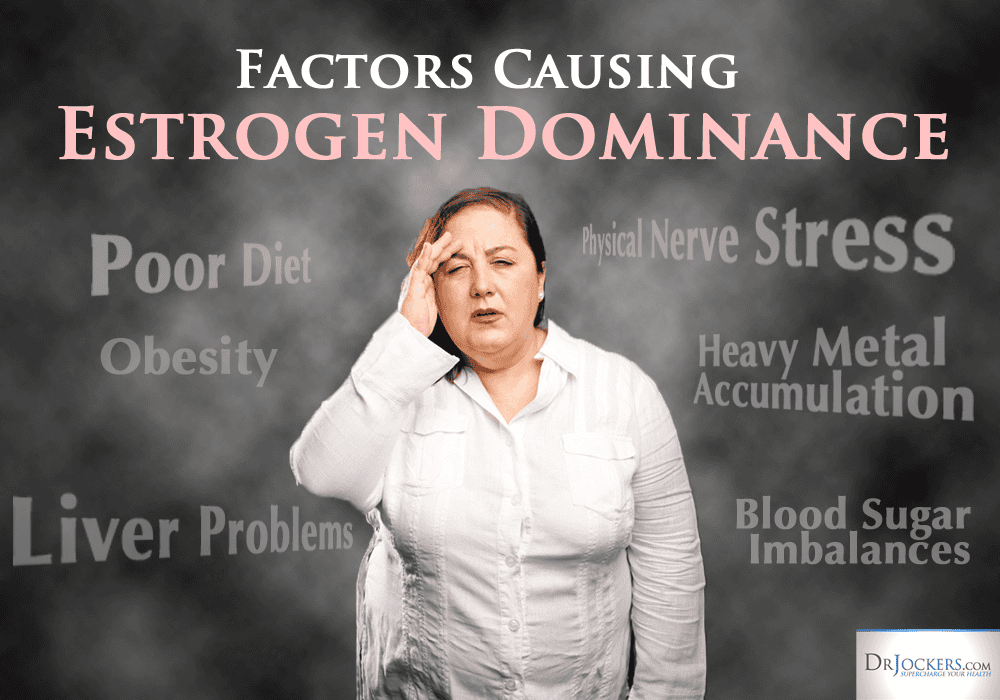It was an interesting day yesterday – I was interviewed on New Zealand’s National Radio about my PhD – what a wonderful opportunity to raise the flag for women’s healthy ageing! If you would like to listen to what I said, then I’ve put the link at the bottom of this article which you can paste into your web browser. It’s always a great privilege to be invited to chat and to explain why we know so little about menopause, especially in the context of exercise.

I so remember when I went around the country talking to the fabulous women who so kindly shared their stories with me when I asked them about the meaning of exercise in their lives now that they were in their 50’s. Every single one of them said that the reason they exercised was because they ‘didn’t want to age like their mother’! What was even more interesting however, was that many of them mentioned that they weren’t sleeping and their exercise, although invigorating, was leaving them tired and they felt that it wasn’t helping much with their weight gain during menopause. At the time, I felt exactly the same and I had no idea, that menopause hormonal changes, insomnia and lots of exercise do not go well together – especially for our weight. Burning fat requires sleep. And for women in menopause, turning around sleep is crucial. It’s why I have a Sleep All Night module for women to listen to as their kick-start into the programmes.
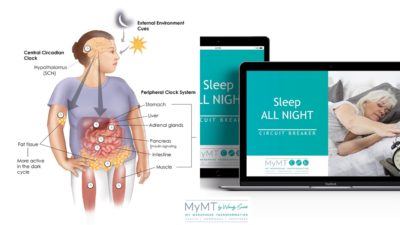 When I went into peri-menopause, I had no idea about the role of oestrogen in our fat cells. I also didn’t know about a condition called ‘Oestrogen Dominance’. It’s getting more press now, but 7 years ago when my reproductive hormones [oestrogen and progesterone] announced that my reproductive years were over, and I wasn’t sleeping, my moods were all over the place and for me, the belly fat was stacking on, my Doctor put me on HRT [hormone replacement therapy]. This little tablet was full of oestrogen and unbeknownst to me at the time, it was the last thing my fat cells might have needed. That’s because for decades my diet and my environment was already full of hormone-disruptors. These disruptors can include house-hold chemicals, high oestrogen foods, compounds, such as bisphenol A (BPA), phthalates from plastics and exposure to heavy metals and all exhibit oestrogenic activity [Lizcano & Guzman, 2014].
When I went into peri-menopause, I had no idea about the role of oestrogen in our fat cells. I also didn’t know about a condition called ‘Oestrogen Dominance’. It’s getting more press now, but 7 years ago when my reproductive hormones [oestrogen and progesterone] announced that my reproductive years were over, and I wasn’t sleeping, my moods were all over the place and for me, the belly fat was stacking on, my Doctor put me on HRT [hormone replacement therapy]. This little tablet was full of oestrogen and unbeknownst to me at the time, it was the last thing my fat cells might have needed. That’s because for decades my diet and my environment was already full of hormone-disruptors. These disruptors can include house-hold chemicals, high oestrogen foods, compounds, such as bisphenol A (BPA), phthalates from plastics and exposure to heavy metals and all exhibit oestrogenic activity [Lizcano & Guzman, 2014].
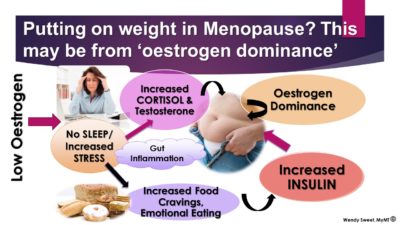 The connection between your changing oestrogen levels in peri-menopause and your weight gain, is controversial. At least in the literature. * Oestrogens and oestrogen receptors regulate various aspects of glucose and lipid (fat) metabolism but it is the disturbances of these signals both from menopause changes and hormone disruptors in the environment that can lead to the development of obesity and higher cardiovascular risk in women during their post-menopause years.
The connection between your changing oestrogen levels in peri-menopause and your weight gain, is controversial. At least in the literature. * Oestrogens and oestrogen receptors regulate various aspects of glucose and lipid (fat) metabolism but it is the disturbances of these signals both from menopause changes and hormone disruptors in the environment that can lead to the development of obesity and higher cardiovascular risk in women during their post-menopause years.
What I’ve discovered with myself and as many of the women on the MyMT Transform Me programme have found out as well, there’s a lot more going on in our body during our menopause transition, than we are led to believe! It isn’t just changing oestrogen and progesterone hormones, which are involved, but also our pituitary hormones (Luteinising Hormone and Follicle Stimulating Hormone) too.
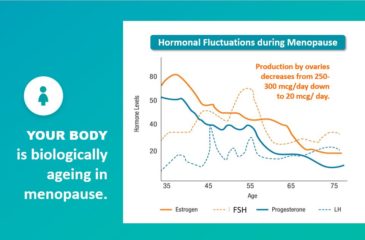 And when the changing reproductive hormonal environment clashes with cortisol (one of your stress hormones) and insulin, (one of your blood sugar regulation hormones), then the combination of poor sleep, hot flushes and weight gain, can cause you metabolic mayhem. Belly fat and upper body fat goes on at an alarming rate, no matter the amount of exercise you are doing.
And when the changing reproductive hormonal environment clashes with cortisol (one of your stress hormones) and insulin, (one of your blood sugar regulation hormones), then the combination of poor sleep, hot flushes and weight gain, can cause you metabolic mayhem. Belly fat and upper body fat goes on at an alarming rate, no matter the amount of exercise you are doing.
When your body is storing more oestrogen than it needs at this time of life, this pushes out the opposing hormone, called progesterone. The term for this is called ‘oestrogen dominance’ and if you are stacking on belly-fat, then please let me help you to turn this around before your metabolic chaos heads you into worsening heart-health as you get older. 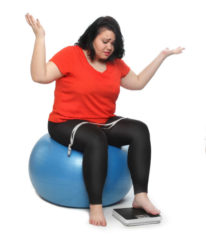 What is Oestrogen Dominance?
What is Oestrogen Dominance?
As far back as the 1970’s, Dr John Lee, from California was inspired to explore the role of progesterone in peri-menopause after noticing that many of his female patients were intolerant to the use of oestrogen replacement therapy. Like a few other doctors and endocrinologists at this time, Dr Lee believed that the distressing symptoms that so many women experienced during menopause were in fact NOT due to the low oestrogen levels, but due to higher than normal amounts of oestrogen present in fat cells in the body. He realised that women with a pre-disposition to put on weight, had higher levels of oestrogen circulating in their blood stream and with new research into obesity, he knew that fat cells are a receptor or storage area for oestrogen too. Because oestrogen, like other hormones, works in harmony with an opposing hormone, Dr Lee, began to explore the role of oestrogen’s opposing hormone, called progesterone. Extra oestrogen stored in fat cells and liver cells can play havoc on progesterone levels, causing progesterone to drop dramatically. So too can high levels of our stress hormone called cortisol and when we don’t sleep, when our exercise levels are too high, or conversely to low, excess storgae of oestrogen dominates the hormonal environment, over-shadowing progesterone. According to Dr Lee, this exacerbatesthe symptoms of low progesterone as the oestrogen is ‘unopposed’. Hence, Dr Lee, coined a term to describe this phenomenon as ‘OESTROGEN DOMINANCE’.
What happens when you become oestrogen dominant?
 Perhaps the most critical concern caused by oestrogen dominance in menopause is that progesterone is too low too soon as we transition our menopause years. This combination of excess oestrogen and low progesterone has numerous effects on our body, including impairing the functioning of cell membranes. Sodium becomes retained and with it so too does water. Many women then feel ‘puffy’ and their ankles begin to swell with the water retention. A situation that is tough for women who already have higher blood pressure, so if this is you, then please get your blood pressure checked regularly with your medical team. Other symptoms of oestrogen dominance also start to be felt – sore and tender breasts, mood disturbances, low motivation, irritability and of course, weight gain, especially around the middle.
Perhaps the most critical concern caused by oestrogen dominance in menopause is that progesterone is too low too soon as we transition our menopause years. This combination of excess oestrogen and low progesterone has numerous effects on our body, including impairing the functioning of cell membranes. Sodium becomes retained and with it so too does water. Many women then feel ‘puffy’ and their ankles begin to swell with the water retention. A situation that is tough for women who already have higher blood pressure, so if this is you, then please get your blood pressure checked regularly with your medical team. Other symptoms of oestrogen dominance also start to be felt – sore and tender breasts, mood disturbances, low motivation, irritability and of course, weight gain, especially around the middle.
Is it bad to become oestrogen dominant?
When our fat cells hold onto more oestrogen, then we typically increase our weight around the middle. And this is where the problem lies as we get older – weight around our middle isn’t great for our heart health and can lead to other metabolic problems such as Type 2 diabetes. I think even tougher though, is the fact that as our weight increases around our middle, we find it harder to do every-day jobs. I know when this happened to me, I felt bloated and the increasing fat deposits around my breasts and my diaphragm left me feeling uncomfortable with exercising. Touching my toes was becoming harder too!
How do we reduce oestrogen stores in fat cells?
When I began to explore what to do to reduce oestrogen dominance and to balance up progesterone again, I realised that this needed a multi-pronged approach (hence the different modules in the Transform Me programme). As I’ve said earlier, the first objective is to turn around your circadian rhythm and sleep all night. Without doing this, your body won’t fat-burn overnight.
The second objective is to restore optimal liver function. Your liver is your toxin remover and it needs to be functioning well to help break down both cholesterol and oestrogen.
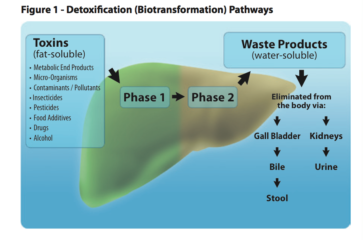 Stress management is also crucial as is managing your chronic stress hormone cortisol. When cortisol levels remain high for much of the day, we feel wired, tired and we hold onto fat and our insulin levels can also become a bit erratic – a perfect storm for putting on more fat!
Stress management is also crucial as is managing your chronic stress hormone cortisol. When cortisol levels remain high for much of the day, we feel wired, tired and we hold onto fat and our insulin levels can also become a bit erratic – a perfect storm for putting on more fat!
When I put together the Transform Me menopause weight loss programme, I knew I had to focus on oestrogen dominance. It’s why I step you through exactly what to do in your learning modules and it’s also why, the first two modules you receive to kick-start your weight loss are Sleep All Night and Are you Oestrogen Dominant? And as I say to women on the programme – your first goal is to stop gaining. When we stop gaining, only then can we begin to lose.
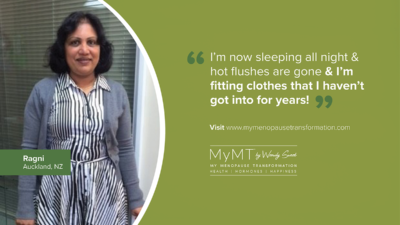 Wendy’s Chat on Radio New Zealand – copy the link into your web-browser:
Wendy’s Chat on Radio New Zealand – copy the link into your web-browser:
https://www.radionz.co.nz/national/programmes/afternoons/audio/2018674435/tell-me-about-your-thesis
Reference*:
Lizcano, F. & Guzmani, G. (2014). Estrogen deficiency and the origin of obesity during menopause.
BioMed Research International, Article ID 757461
